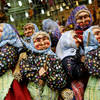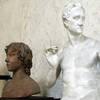"The World of Falling in Love… Through Love Letters." A Conversation with Sonia Cancian
The Museo della lettera d’amore is a most unique museum in Italy, rather the only museum in the world to focus solely on love letters. Hosted in the Palazzo del Marchese Valignani, in the 4000-inhabitants town of Torrevecchia Teatina, and directed by Massimo Pamio, for a number of years the museum has hosted several creative events with authors and other experts on the theme of love letters especially within the framework of the “Lettere d’amore dall’Italia” series. This year’s Valentine’s Day event fearured a lecture by Dr. Sonia Cancian. Born in Canada in an Italian family, Sonia Cancian, a professor at Zayed University in Dubai, is a social historian whose specialization is anchored in the field of Italian migration. Her focus for this conference will be on her most recent book which explores the epistolary relationship between two individuals writing in the late 1940s between Venice and Montreal. A few days ago, we had the pleasure to interview Sonia Cancian. Here are excerpts of our conversation.
As a historian who specializes in migration history, among other things, you have developed a special interest in "Italian migrant love letters." How did it happen and what have you learned from your research?
Like many things we treasure in our lives, my scholarly interest in letters, and particularly migrant love letters, happened serendipitously and over time.
To begin with, as a child I remember being fascinated by the letters of my grandparents safely guarded by my father, and by my family’s experiences of “neither here, nor there,” to quote Professor Donna Gabaccia, meaning our migration experience that influenced many aspects of our lives—from the food we ate, the clothing my mother sewed for us (and later bought), the culture that surrounded us, the economics of living, our identity growing up as a second generation Italian-Canadian, our dreams, our travels home to Italy, our schooling, the literature we relished, the history that we could relate to, etc. Then, in 1986, I travelled to Spilimbergo (PN) to visit my paternal grandmother, and there, I was introduced to the extraordinary amorous writings of my grandparents. She kept the letters in a white shoebox, I remember distinctly, a shoebox that was nowhere to be found once she passed away, disappeared. I remember that day as though it were yesterday. There she was, standing next to me as she opened the box of letters that she and my grandfather had exchanged in the late 1920s. As she opened one of the envelopes, there on the thin, neatly transparent paper with ink bleeding through was my grandfather’s calligraphy crystallizing words of affection for my grandmother while he had been away in Amiens, France.
Love and the writing of love in letters remains at the heart of our stories as human beings. For migrants, refugees, and exiles, these letters carry the additional weight of a past anchored in a transnational space--loves past, loves found, and loves rekindled in the memory and in the present. Many times letters of this nature remain forgotten in a drawer, a shoebox, or tucked away in a dust-covered suitcase of one’s home. As material evidence of intimate relationships, migrant letters of this nature underscore the centrality of a constellation of emotions (loss, grief, guilt, nostalgia, hate, euphoria, and joy) and a defining individual experiences of mobility in relation to self, family, and nation.
As a Canadian of Italian origin, you dedicated your book on Italian postwar emigration to Canada as seen through these letter, Families, Lovers, and their Letters: Italian Postwar Migration to Canada (Winnipeg: University of Manitoba Press, 2010). Can you tell us something about the book, and your experience in writing it?
The book, Families, Lovers, and their Letters engages with a multidisciplinary historiography grounded in social history, migration history, feminist ethnography, and literary studies. It draws its findings predominantly from one primary source, letters of people who lived in primarily oral cultures and did not normally employ literary expression in their everyday lives. These letters in conditions in which we can presume were written “in the moment” on both sides of the ocean as migration was bringing changes to the daily lives, dreams, and opportunities of migrants and their loved ones. This study addresses two main research questions: First, what do the personal letters of ordinary individuals reveal about the impact of migration experienced by Italian migrants in Canada and their kin and lovers who remained in Italy during the postwar years? Second, what strategies and social, cultural, and emotional responses to migration do the letters reveal from the viewpoint of these actors? Drawing on an analysis of over 400 private letters belonging to six different families, I explore the multiple layers of significance that these letters hold both historically and anthropologically in conversation with the rapidly growing scholarly interest in immigrants’ letters. The letters I analyze have been drawn from an original archive of 800 letters that I located and collected. These letters are unique in scope and original in the sense that they have never previously been archived or analyzed. Both individually and collectively, they offer a new source on the history of postwar Italian migration to Canada. Largely of a private and semi-private nature, these letters take us inside the minds and hearts of ordinary people whose personal and family identities and circumstances were most affected by the realities of international migration. Writing the book has been an intensely personal and intellectual experience. But that is not all. Here too, the personal is political.
At the present you are working on a new book based on letters from two lovers one of whom left Italy just after WWII. Can you tell us a little about the book?
The epistolary story of Antonietta Petris and Loris Palma takes us from a rather ordinary love story of a young couple falling in love at the end of the Second World War to an extraordinary love story that unfolds amid longing, resilience, nostalgia, music, romantic ideals and desires, and migration across long distances and time. Their letters—originally written solely for one another-- allow us to pry open their intimate worlds as they viewed and experienced them. What led this couple to believe in their relationship and stay the course during perennial periods of separation within Italy and later, transnationally between Italy and Canada? What kind of mechanisms did they consciously and unconsciously employ in their letters to pull the absent lover closer, to hold a lover's ear, and to remain faithful and complicit throughout the months and year of absence? In what ways does the process of migration underpin the correspondence of the lovers? More generally, what kind of findings do letters of this nature provide in the history of migration and the history of emotions? The answers to these and other questions are woven in the love story of Antonietta and Loris told through their letters.
You must feel a little like and "archaeologist" today. It seems that there are love letters are waning from our world in light of the Internet, emails, skype, and social networks. There are many aspects to explore here... but isn't it also sad that we are losing the experience of writing letters?
So much to say about this! However, in sum, the extraordinary personal letters of migrants and their loved ones speak to nostalgia and technology, and about the so-called lost art of letter-writing, even though I’m not sure the practice of letter-writing is entirely dead. They speak also about romantic love, compelling us to ask if the love our grandparents experienced is buried in the past or still part of our present. The letters also remind us of the experiences of familial love, of detachment and loss, of the enormous resilience and agency of our parents, our grandparents, ourselves, and migrants and refugees currently facing enormous displacements in light of the most significant migration crisis we are facing since World War II. The letters speak about the depths of our humanity over time and space, the need to reach out, to sustain ties, to desire, to dream, and to love, as part of a larger global community.












































i-Italy
Facebook
Google+
This work may not be reproduced, in whole or in part, without prior written permission.
Questo lavoro non può essere riprodotto, in tutto o in parte, senza permesso scritto.